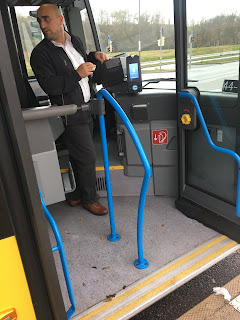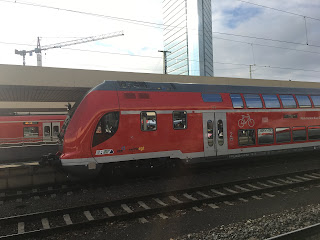High speed rail
 |
| German ICE train and French TGV |
 |
| German ICE train interior design |
Buses
 |
| Stuttgart Citaro artic buses (Photo Philipsen) |
There is a large open area behind the center door for placing wheel chairs, strollers and the like. The doors are wide and largely glazed allowing easy view and use. The wide pneumatically operated doors are a far cry from the flimsy folding doors of the New Flyer buses in the US. However, the difference is not only one of technology, but more one of demographics. The SSB and their bus maker don't seem to worry about fare cheaters boarding through rear doors, the chief reason why the New Flyer narrow rear doors fit only a person at a time and flap shut so fast that they often hit disboarding passengers.
The Citaro front access allows two lanes for boarding, one for cash payers and one for prepaid tickets. There is a reader for electronic tickets similar to what airlines uses for boarding passes. Cash payers put their money on an open tray and the operator will give change into another tray from a coin holder. The SSB offers multiple trip tickets which have to be inserted into a validator where they get notched and stamped. There are also day passes, weekly and monthly passes. Plainclothes fare inspections are frequent and carry an element of surprise. (The inspectors cannot be spotted from how they are dressed). The fact that change is made in Germany and not in the US also has to do with the US experience that operators were frequently threatened to give up their cash until the fares disappared in a sealed box that is so solid, that nobody has access to it without special tools.
 |
| Two lane entry and ticket reader (Photo Philipsen) |
The operator has two electronic displays, one for ticket info and one for route info. All stops are shown in sequence and with their scheduled times. Passenger have a screen display in view that shows the route, the current location, the upcoming stops with estimated time to the stop and when the bus stops all the transfers at this location with real time display of the connections in minutes. The lastest models offer USB charging ports for selected seats. There are male and female bus operators, of course, all navigated their large vehicles through the often tiny streets competently, souveraine and with pride as much as one can judge this. People never leave the bus through the front door, thanks to a mechanical arm that moves only one way and the rules which Germans like to obey. There is little or no banter even though, unlike at the US counterpart, seats are mounted on the front wheel wells directly behind the driver. The operators I saw showed little interest in the visual fare identification, apparently relying on the random fare inspectors instead.
The buses are diesel or diesel electric. Mercedes currently doesn't offer a full electric bus to transit agencies, according to a city council representative who tried to use a federal grant for emission free buses (They offer CNG) and was rebuffed by the manufacturer. Diesel emissions are a big problem in Germany, and espcially in Stuttgart where the city will enact diesel prohibitions for older diesel vehicles starting January 2019 for large parts of the city where fine particle and NOx is too high.
Headways for buses and trams during peak hours are as low as 5 minutes and as high as 20 minutes. The fares vary by zone and start with short trips at about $1.50. The tickets are valid for the entire regional transit compact VVS with over 30 providers including bus and rail. The full network day pass costs about $18 and allows trips far into the areas as far as 30 miles from the center city. In my trips no train or bus was more than 3 minutes late, trains usually arrived within the advertised minute.
Every passenger is different, some are sitting, others may prefer. If you care about all people equally, and you want to make sure that everyone reaches their destination safely, whenever needed, then your welcome as: Bus driver in regular transit service. In the activity as a bus driver you provide sovereign and reliably always safe transport for our passengers in the metropolitan area Stuttgart. Of course, you also take care of the sale and the control of tickets. You are also responsible for passenger information on fare and route issues. During the 14-week full-time training, we will qualify you at our in-house driving school in Stuttgart-Möhringen for use in the regular service of the SSB. For the training as a bus driver you bring: Driver's license class B for min. 2 years, completed vocational training (desirable), adequate knowledge of German, willingness to shift work, also on weekends and holidays and technical understanding, a minimum age of 24 years. (Job offer of the SSB).Bus and rail operators at the SSB earn on average about $42k annually (gross). Earlier this year their union organized a strike for a 6% raise.
 |
| Operator's cabin with route monitor and cash changer German transit bus (Photo Philipsen) |
Light Rail
Many German cities have some form of light rail which sometimes is more like a streetcar and sometimes more like a subway. The Stuttgart light rail system is signed with a blue capital U, typically used for German subways (Underground) due to the fact that the trains are articulated doubles or two-car consists with two articulated trains which run underground in the central city. Where they run on the surface, they have their own right of way in the median or alongside of roadways. Trains principally manage traffic signals and have full preemption.
All tickets have to be prepaid on rather old fashioned vending machines which do not accept credit cards. There are no readers for tickets on a mobile phone anywhere and I am not clear how those would be handled except that fare inspectors would accept them. It seems that SSB and VVS aren't big on counting their riders.
S Trains
The S train category, common in some European countries, is a bit confusing for visitors from overseas. They are in part heavy rail regional trains and in part subway. However, except for Berlin, they are usually operated by German Rail or its subsidiaries and often share tracks with other trains. This is easy since they use overhead catenary and not third rail (except, again, in Berlin) like metro trains. They can also be quite long. Where the urban system has no underground portion, the trains use frequently double- decker coaches. In cities with dead end main stations (Frankfurt, Stuttgart and many others) S Bahns now circulate underneath the inner city in an underground system that looks and feels like any real subway except for the lack of third rail. In Stuttgart the SSB U-trains and the DB S trains together provide an underground rail network comparable to DC or San Francisco.
 |
| German S commuter train doubl- decker coach. (Photo Philipsen) |
The latest generation S trains are coupled in such a way that three long coaches form an uninterrupted interior allowing unobstructed views from end to end of each train unit. Those trains, of course, don't use engines but are self propelled like the ICE trains. Just like the buses, the S trains and latest U trains offer displays with route, stations and connections. Upon arrival, bus terminals are placed at the stations with buses coordinated with and waiting for arriving trains. Thanks to the regional ticket system, no new ticket is needed at the transfer.
The VVS offers an app that allows trip planning, ticket purchase, ticket display, real time information about escalators and elevators and possible disruptions. While not as user friendly as, for example, the US Transit app, the VVS app offers a while range of user options which go beyond what Transit or Google maps can do.
All in all, transit use in Europe is far easier and much more common than in Europe whereby it isn't entirely clear what is the chicken, and what the egg. As we have seen, that the European bus isn't only a means of transportation for those who have no other choice but is widely accepted as a reliable way for getting around by all segments of the population is one of the reasons why even bus design can be more user friendly.
Alternative modes
There are no electric share scooters, no dockless bikes and no Uber or Lyft in Stuttgart or most other German cities. (Except Berlin). The Germans can't tolerate the largely unregulated state of these systems. A federal government workgroup just came up with the idea that scooters need to be licensed, have a license plate and turn signals (!).
Meanwhile the big boys try to keep business to themselves: Daimler Benz operates many of their own brand (electric) Car to Go Smart Cars and even offers a transit app with their cars as a last mile option. The docked bikes in Suttgart (and many other cities) are operated by Deutsche Bahn. In this way, it all goes its orderly way and disrupters are kept at bay in Germany, not necessarily a competitive advantage.
Klaus Philipsen, FAIA
 |
| Buffet car in the ICE train |
 |
| Double-decker commuter train near Los Angeles (Photo Philipsen) |
 |
| US transit bus San Diego (Photo Philipsen) |
 |
| Stuttgart Transit bus Citaro (Photo Philipsen) |
 |
| Stuttgart light rail interior (Photo Philipsen) |
 |
| Center door as exit and entry for mobility impaired and strollers (Photo Philipsen) |
 |
| Intermodal stop underground light rail/ bus with real time service indicator sign (Photo Philipsen) |
 |
| Stuttgart cog rail train (Photo Philipsen) |
 |
| Stuttgart S train in underground station: Like a subway (Photo Philipsen) |
 |
| Interior of modern S train: No obstructions between the coaches Onboard bus #44 indicator showing route, arrival times and connections (below) (Photo Philipsen) |

 |
| The VVS rail network |










No comments:
Post a Comment